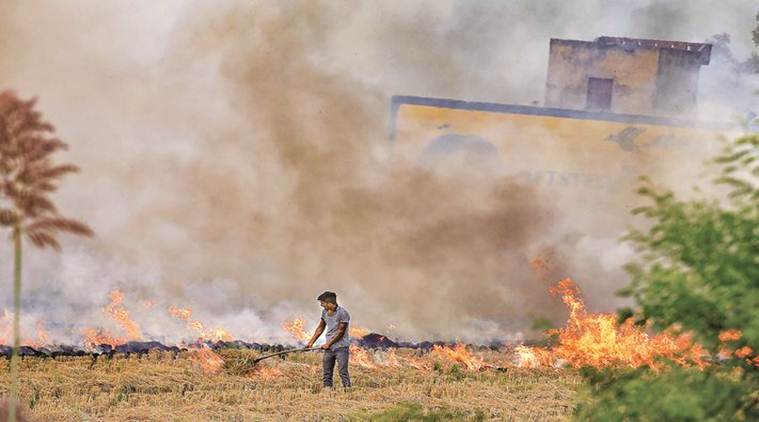Why are Punjab govt, farmers demanding compensation for stubble management?
Both farmers and Punjab CM Amarinder Singh have been demanding cash incentive as ‘cost compensation’/’bonus’ to stop burning crop residue.
 From the last paddy season, Punjab has witnessed nearly 56,678 field fires across the state.
From the last paddy season, Punjab has witnessed nearly 56,678 field fires across the state.
Despite the Centre approving a grant of Rs 665 crore to Punjab for a two year period till 2020 for subsidised machinery for stubble management and the state distributing over 50,000 such machines, stubble burning continues unabated in the state. ANJU AGNIHOTRI CHABA explains why both farmers and Punjab CM Amarinder Singh have been demanding cash incentive as ‘cost compensation’/’bonus’ to stop burning crop residue.
How many field fires have been reported in Punjab ever since the state started distributing machines on subsidy?
Punjab government started providing stubble management machines from the last paddy season. Despite that Punjab has witnessed nearly 56,678 field fires across state since then, including 11,698 in wheat season, over 4373 in the ongoing paddy season and 40,607 in the last paddy season. Even during wheat harvesting in April-May this year, Punjab farmers had burnt 50 per cent of the wheat fields of the state which was 10 per cent more in terms of area as compared to 2018.
How much stubble is produced in the state?
In Punjab, nearly 64-65 lakh hectares area comes under paddy and wheat crops. This year, 29.20 lakh hectares is under rice including 22.91 lakh under paddy and 6.29 lakh hectares under Basmati rice. Around 35 lakh hectares area was under wheat during last Rabi season. While paddy produces over 20 million tonnes of stubble, the wheat crop produces around 18 million tonnes residue, but most of the wheat residue is used to make the dry fodder for cattle in Punjab.
What type of machines are distributed?
Among the 50,000 machines made available since September last year, there around 14,000 Happy Seeders, 6000 Super Stubble Management Systems (Super SMS), an attachment with the existing Combine harvester, 8000 choppers and mulchers, 350 balers, 4000 MB Ploughs, 5000 rotabators, while the remaining are shrub masters, cutter cum spreaders and zero till drills. These machines are provided on 50 per cent to 80 per cent subsidy to individuals and groups, respectively.
How do these machines manage stubble?
Super SMS and Happy Seeders are considered most effective machines for stubble management. While Super SMS attachment with combine harvester helps in chopping the stubble and spreading that evenly in the filed at the time of paddy harvesting itself, the Happy Seeder helps in direct showing of wheat without clearing the stubble, which can sow wheat in around 16 inches standing stubble. And where both these machines are not available to farmers, farmers can use chopper & mulcher, baler, MB plough for chopping, making bales of stubble and mixing the stubble in the soil, respectively while zero till drill can be used for sowing in the absence of Happy Seeder.
Are these machines helpful?
Going by the area of paddy and wheat in Punjab these machines cannot cover even half the area due to short window period between paddy harvesting and wheat sowing . The paddy harvesting starts from first week of October while wheat sowing starts from November 1. According to Agriculture Department in Punjab, the best wheat sowing period is between November 1 to November 15.
There is a 20-day period between paddy harvesting and wheat sowing with the farmers and during that period these machines cannot cover even one-third of the total area under these crops.
A harvester with Super SMS can harvest around 12-15 acres in a day and if 6000 harvesters with Super SMS are run then these can harvest around 22.50 lakh acres (9.10 lakh hectares) in a period of around 25 days which is less than one-third of the total area under rice in Punjab.
Similarly, Happy Seeder can sow 7-8 acres land in a day and in period of 25 days (due to extended sowing period) it can sow only 28 lakh acres (11.33 lakh hectares) which is one-third of the total area under wheat in Punjab. Also if the sowing is extended for even one more week not more that couple of lakh hectares more would be covered. Apart from this, other machines too cannot cover more than 2 to 3 lakh acres. To cover entire area with machines, Punjab needs at least three times the number of machines available now.
Why farmers and the state government want ‘bonus’?
While farmers have demanded Rs 200 bonus for per quintal paddy, Punjab CM has demanded Rs 100 per quintal paddy. This would come around Rs 3000 per acre at the rate of Rs 100 per quintal as the yield of paddy is 29 to 30 quintal per acre.
Farmers claim that they need bonus as machines are not available to every farmers in Punjab due to which they have to engage manual labour to clear stubble. If machines are taken on rent, then it costs the farmer extra, for which they are demanding monetary compensation.
“We have 68 per cent farmers with less than five acres of land who cannot afford to spend Rs 2500-3000 extra per acre to avail these machines as every such machine is available at the rent of Rs 1200 to 1800 per acre,” said Bhartiya Kisan Union (BKU) Ekta Dakaunda general secretary Jagmohan Singh, adding that with the bonus farmers can hire labour to clear the stubble or if they get machines on rent then they can pay from this amount.
He added: “Both machines and bonus are needed to curb stubble burning.”
- 01
- 02
- 03
- 04
- 05






































